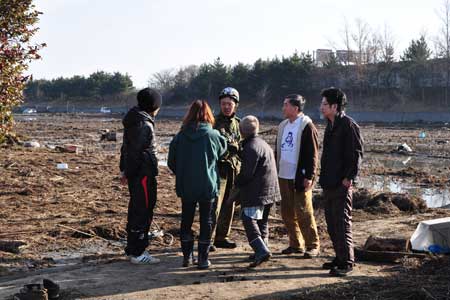14 March 2011
Embracing the World has sent its first group of local volunteers from our Japan Center to Sendai—the major city nearest the epicenter of the earthquake, and hit hard by both the quake (Japan’s worst-ever) and the subsequent tsunami. At Amma’s request, the ETW representatives went to Sendai in order to study the situation on the ground and also to distribute food and water for the refugees.

We set out for Sendai, Miyagi Prefecture on 13 March, within 3 days of the disaster. Because all the highways going north are completely locked down for military and authorized use only, we had to take the ordinary road for approximately 400 kilometers. On the way, we had to drive through an area just 40 kilometers away from the Fukushima nuclear plants, which have started emitting dangerous radiation.
On the day of our journey, the officially announced death toll here in Japan was at 4,400 people, including people officially declared ‘missing’. However, it is widely said that the whereabouts of tens of thousands are as yet unknown. Aftershocks are still very frequent—we had 47 aftershocks just in the morning on the day we set out. The aftershocks only add to the tension and fear of the refugees.
In Sendai, the scarcity of food and drink seems the most prominent problem—simply because the supermarkets and convenience stores are all out of stock.
We brought with us some rice balls, cookies, popcorn and water bottles from our Tokyo center. We distributed everything we brought along with us in the nice park located in the Sendai City’s downtown district. In this warm and quiet park, many refugees had gathered and were spending their third day here.
Two high-school boys, who came from the neighboring prefecture of Iwate, told us they had been visiting a college in Sendai for an open-campus day when the earthquake struck. One boy said his house in Iwate was ‘washed away’ by the tsunami. I did not have the heart to ask him how his parents were, feeling that he was already hinting me about it with his eyes. There has been no public transportation to Iwate, or any other place, since then, and the boys were trapped here—washing their bodies in the park’s water tap.
There were quite a few elderly people who were sitting all alone.
One young couple huddled very closely together on a bench initially did not want to take the food packets we offered, saying, ‘”We are less unfortunate, at least having had something to eat ourselves. So please give it to other people who are more in need.”
When we told them, “Don’t worry about that… we came all the way from Tokyo just to do this—please take this!” their faces lit up with smile and they took the packets and thanked us.
The people who do not have any place to go are easily recognizable—they are the ones who have only one or two bags with them, overstuffed with many things. The sudden change that has come upon their lives is obvious in every aspect of their appearance and their belongings.
From the expressions of those who accepted our packets, we can see that they are really grateful for any gesture of support. The level of gratitude they expressed makes it all the more clear that food for the refugees is really an urgent need.
All three of us were busy distributing the food so we were not able to take photos of the food distribution. However, those sad faces and the following smiles were recorded deep in our hearts.

On our way back, we came across an elderly woman of 78 years who has a house and workshop four kilometers away from the seashore in Sendai. The house was half-collapsed by the tsunami. She had actually been a victim of magnitude 7.4 Miyagi Earthquake in 1978, when the same house was severely damaged. This time, the water came up above her knees, but she dashed out and managed to drive to safety. Now she had come back to see what was left of her house.
Nearby, on the other side of the raised-up roadway, is what is referred to as the “unsearched area.” Neighbors told us that the area is still covered deeply by tsunami mud, and the search for houses and people has not yet begun. While we were there, the National Defense Force officer came by for the first time there, and started an inspection, trying to clear away the blockages leading to the unsearched area.
Spring usually comes late to this Northeastern Region, and we could see nearby mountains still lightly covered with the snow.
On the way back to Tokyo, we took a detour route for 680 kilometers, in order to avoid passing again near the Fukushima nuclear power plant, the fate of which had become much more uncertain during our stay in Sendai.
We were also able to visit some of Amma’s devotees and we are happy to confirm that they are doing all right in spite of these hardships.
Amritesh Ito


Leave a Reply
You must be logged in to post a comment.